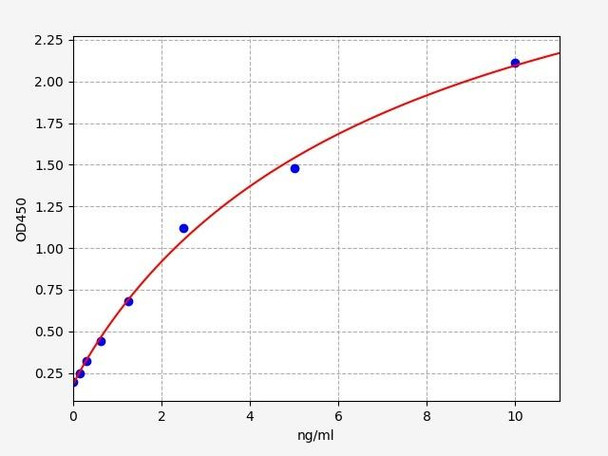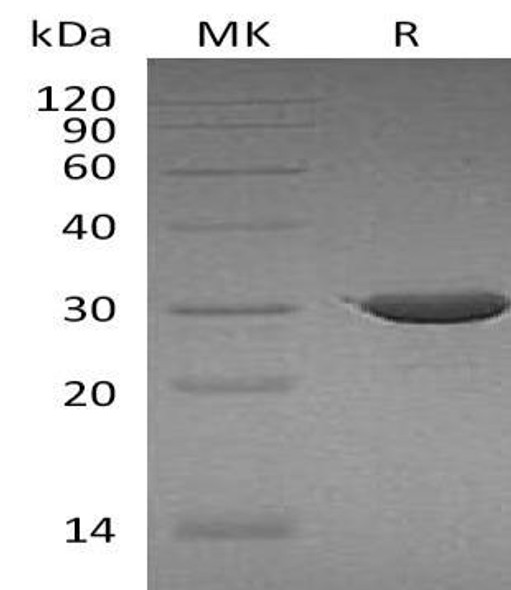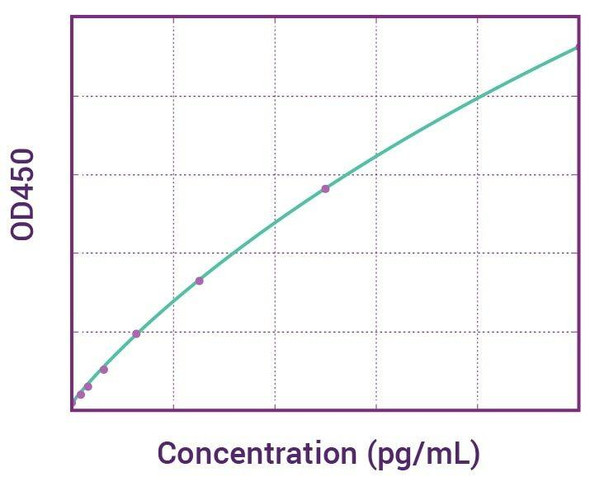Human ABCB5 ELISA Kit (HUFI00914)
- SKU:
- HUFI00914
- Product Type:
- ELISA Kit
- Size:
- 96 Assays
- Uniprot:
- Q2M3G0
- Sensitivity:
- 0.094ng/ml
- Range:
- 0.156-10ng/ml
- ELISA Type:
- Sandwich
- Synonyms:
- ABCB5, ATP-binding cassette sub-family B member 5, ABCB5 P-gp, ABCB5alpha, ABCB5beta, ATP-binding cassette protein, ATP-binding cassette, sub-family B, MDR, TAP, member 5, P-glycoprotein ABCB5
- Reactivity:
- Human
- Research Area:
- Developmental Biology
Description
Human ABCB5 ELISA Kit
The Human ABCB5 ELISA Kit is a powerful tool for quantifying ABCB5 levels in human samples such as serum, plasma, and cell culture supernatants. With its high sensitivity and specificity, this kit delivers accurate and reproducible results, making it an invaluable asset for various research endeavors.ABCB5 is a key protein known for its role in drug resistance and stem cell function.
By measuring ABCB5 levels, researchers can gain valuable insights into drug resistance mechanisms and potential treatment strategies for various diseases, including cancer. This ELISA kit is essential for studying ABCB5's impact on drug efficacy and disease progression, offering researchers a reliable method for exploring new therapeutic approaches.
| Product Name: | Human ABCB5 ELISA Kit |
| Product Code: | HUFI00914 |
| Size: | 96 Assays |
| Alias: | ABCB5, ATP-binding cassette sub-family B member 5, ABCB5 P-gp, ABCB5alpha, ABCB5beta, ATP-binding cassette protein, ATP-binding cassette, sub-family B, MDR, TAP, member 5, P-glycoprotein ABCB5 |
| Detection method: | Sandwich ELISA, Double Antibody |
| Application: | This immunoassay kit allows for the in vitro quantitative determination of Human ABCB5 concentrations in serum plasma and other biological fluids. |
| Sensitivity: | 0.094ng/ml |
| Range: | 0.156-10ng/ml |
| Storage: | 4°C for 6 months |
| Note: | For Research Use Only |
| Recovery: | Matrices listed below were spiked with certain level of Human ABCB5 and the recovery rates were calculated by comparing the measured value to the expected amount of Human ABCB5 in samples. | ||||||||||||||||
| |||||||||||||||||
| Linearity: | The linearity of the kit was assayed by testing samples spiked with appropriate concentration of Human ABCB5 and their serial dilutions. The results were demonstrated by the percentage of calculated concentration to the expected. | ||||||||||||||||
| |||||||||||||||||
| CV(%): | Intra-Assay: CV<8% Inter-Assay: CV<10% |
| Component | Quantity | Storage |
| ELISA Microplate (Dismountable) | 8×12 strips | 4°C for 6 months |
| Lyophilized Standard | 2 | 4°C/-20°C |
| Sample/Standard Dilution Buffer | 20ml | 4°C |
| Biotin-labeled Antibody(Concentrated) | 120ul | 4°C (Protect from light) |
| Antibody Dilution Buffer | 10ml | 4°C |
| HRP-Streptavidin Conjugate(SABC) | 120ul | 4°C (Protect from light) |
| SABC Dilution Buffer | 10ml | 4°C |
| TMB Substrate | 10ml | 4°C (Protect from light) |
| Stop Solution | 10ml | 4°C |
| Wash Buffer(25X) | 30ml | 4°C |
| Plate Sealer | 5 | - |
Other materials and equipment required:
- Microplate reader with 450 nm wavelength filter
- Multichannel Pipette, Pipette, microcentrifuge tubes and disposable pipette tips
- Incubator
- Deionized or distilled water
- Absorbent paper
- Buffer resevoir
| Uniprot | Q2M3G0 |
| UniProt Protein Function: | ABCB5: Plasma membrane transporter able to mediate efflux from cells of the rhodamine dye and of the therapeutic drug doxorubicin. Responsible for the resistance to doxorubicin of a subset of malignant melanomas. Belongs to the ABC transporter superfamily. ABCB family. Multidrug resistance exporter (TC 3.A.1.201) subfamily. 2 isoforms of the human protein are produced by alternative splicing. |
| UniProt Protein Details: | Protein type:Transporter, ABC family; Transporter; Membrane protein, integral; Membrane protein, multi-pass Chromosomal Location of Human Ortholog: 7p21.1 Cellular Component: integral to plasma membrane; plasma membrane Molecular Function:ATP binding; ATPase activity, coupled to transmembrane movement of substances; efflux transmembrane transporter activity Biological Process: antigen processing and presentation of endogenous peptide antigen via MHC class I via ER pathway, TAP-dependent; antigen processing and presentation of endogenous peptide antigen via MHC class Ib via ER pathway, TAP-dependent; antigen processing and presentation of exogenous protein antigen via MHC class Ib, TAP-dependent; cell differentiation; compound eye corneal lens development; metabolic process; positive regulation of antigen processing and presentation of peptide antigen via MHC class I; regulation of membrane potential; transmembrane transport |
| NCBI Summary: | ABCB5 belongs to the ATP-binding cassette (ABC) transporter superfamily of integral membrane proteins. These proteins participate in ATP-dependent transmembrane transport of structurally diverse molecules ranging from small ions, sugars, and peptides to more complex organic molecules (Chen et al., 2005 [PubMed 15760339]).[supplied by OMIM, Mar 2008] |
| UniProt Code: | Q2M3G0 |
| NCBI GenInfo Identifier: | 693586060 |
| NCBI Gene ID: | 340273 |
| NCBI Accession: | Q2M3G0.4 |
| UniProt Secondary Accession: | Q2M3G0,Q2M3I5, Q5I5Q7, Q5I5Q8, Q6KG50, A4D131, A7BKA4 B5MD19, B7WPL1, F8QQP8, F8QQP9, J3KQ04, |
| UniProt Related Accession: | Q2M3G0 |
| Molecular Weight: | 89,832 Da |
| NCBI Full Name: | ATP-binding cassette sub-family B member 5 |
| NCBI Synonym Full Names: | ATP binding cassette subfamily B member 5 |
| NCBI Official Symbol: | ABCB5 |
| NCBI Official Synonym Symbols: | ABCB5beta; EST422562; ABCB5alpha |
| NCBI Protein Information: | ATP-binding cassette sub-family B member 5 |
| UniProt Protein Name: | ATP-binding cassette sub-family B member 5 |
| UniProt Synonym Protein Names: | ABCB5 P-gp; P-glycoprotein ABCB5 |
| Protein Family: | ABC transporter B family |
| UniProt Gene Name: | ABCB5 |
| UniProt Entry Name: | ABCB5_HUMAN |
*Note: Protocols are specific to each batch/lot. For the correct instructions please follow the protocol included in your kit.
Before adding to wells, equilibrate the SABC working solution and TMB substrate for at least 30 min at 37°C. When diluting samples and reagents, they must be mixed completely and evenly. It is recommended to plot a standard curve for each test.
| Step | Protocol |
| 1. | Set standard, test sample and control (zero) wells on the pre-coated plate respectively, and then, record their positions. It is recommended to measure each standard and sample in duplicate. Wash plate 2 times before adding standard, sample and control (zero) wells! |
| 2. | Aliquot 0.1ml standard solutions into the standard wells. |
| 3. | Add 0.1 ml of Sample / Standard dilution buffer into the control (zero) well. |
| 4. | Add 0.1 ml of properly diluted sample ( Human serum, plasma, tissue homogenates and other biological fluids.) into test sample wells. |
| 5. | Seal the plate with a cover and incubate at 37 °C for 90 min. |
| 6. | Remove the cover and discard the plate content, clap the plate on the absorbent filter papers or other absorbent material. Do NOT let the wells completely dry at any time. Wash plate X2. |
| 7. | Add 0.1 ml of Biotin- detection antibody working solution into the above wells (standard, test sample & zero wells). Add the solution at the bottom of each well without touching the side wall. |
| 8. | Seal the plate with a cover and incubate at 37°C for 60 min. |
| 9. | Remove the cover, and wash plate 3 times with Wash buffer. Let wash buffer rest in wells for 1 min between each wash. |
| 10. | Add 0.1 ml of SABC working solution into each well, cover the plate and incubate at 37°C for 30 min. |
| 11. | Remove the cover and wash plate 5 times with Wash buffer, and each time let the wash buffer stay in the wells for 1-2 min. |
| 12. | Add 90 µl of TMB substrate into each well, cover the plate and incubate at 37°C in dark within 10-20 min. (Note: This incubation time is for reference use only, the optimal time should be determined by end user.) And the shades of blue can be seen in the first 3-4 wells (with most concentrated standard solutions), the other wells show no obvious color. |
| 13. | Add 50 µl of Stop solution into each well and mix thoroughly. The color changes into yellow immediately. |
| 14. | Read the O.D. absorbance at 450 nm in a microplate reader immediately after adding the stop solution. |
When carrying out an ELISA assay it is important to prepare your samples in order to achieve the best possible results. Below we have a list of procedures for the preparation of samples for different sample types.
| Sample Type | Protocol |
| Serum | If using serum separator tubes, allow samples to clot for 30 minutes at room temperature. Centrifuge for 10 minutes at 1,000x g. Collect the serum fraction and assay promptly or aliquot and store the samples at -80°C. Avoid multiple freeze-thaw cycles. If serum separator tubes are not being used, allow samples to clot overnight at 2-8°C. Centrifuge for 10 minutes at 1,000x g. Remove serum and assay promptly or aliquot and store the samples at -80°C. Avoid multiple freeze-thaw cycles. |
| Plasma | Collect plasma using EDTA or heparin as an anticoagulant. Centrifuge samples at 4°C for 15 mins at 1000 × g within 30 mins of collection. Collect the plasma fraction and assay promptly or aliquot and store the samples at -80°C. Avoid multiple freeze-thaw cycles. Note: Over haemolysed samples are not suitable for use with this kit. |
| Urine & Cerebrospinal Fluid | Collect the urine (mid-stream) in a sterile container, centrifuge for 20 mins at 2000-3000 rpm. Remove supernatant and assay immediately. If any precipitation is detected, repeat the centrifugation step. A similar protocol can be used for cerebrospinal fluid. |
| Cell culture supernatant | Collect the cell culture media by pipette, followed by centrifugation at 4°C for 20 mins at 1500 rpm. Collect the clear supernatant and assay immediately. |
| Cell lysates | Solubilize cells in lysis buffer and allow to sit on ice for 30 minutes. Centrifuge tubes at 14,000 x g for 5 minutes to remove insoluble material. Aliquot the supernatant into a new tube and discard the remaining whole cell extract. Quantify total protein concentration using a total protein assay. Assay immediately or aliquot and store at ≤ -20 °C. |
| Tissue homogenates | The preparation of tissue homogenates will vary depending upon tissue type. Rinse tissue with 1X PBS to remove excess blood & homogenize in 20ml of 1X PBS (including protease inhibitors) and store overnight at ≤ -20°C. Two freeze-thaw cycles are required to break the cell membranes. To further disrupt the cell membranes you can sonicate the samples. Centrifuge homogenates for 5 mins at 5000xg. Remove the supernatant and assay immediately or aliquot and store at -20°C or -80°C. |
| Tissue lysates | Rinse tissue with PBS, cut into 1-2 mm pieces, and homogenize with a tissue homogenizer in PBS. Add an equal volume of RIPA buffer containing protease inhibitors and lyse tissues at room temperature for 30 minutes with gentle agitation. Centrifuge to remove debris. Quantify total protein concentration using a total protein assay. Assay immediately or aliquot and store at ≤ -20 °C. |
| Breast Milk | Collect milk samples and centrifuge at 10,000 x g for 60 min at 4°C. Aliquot the supernatant and assay. For long term use, store samples at -80°C. Minimize freeze/thaw cycles. |






